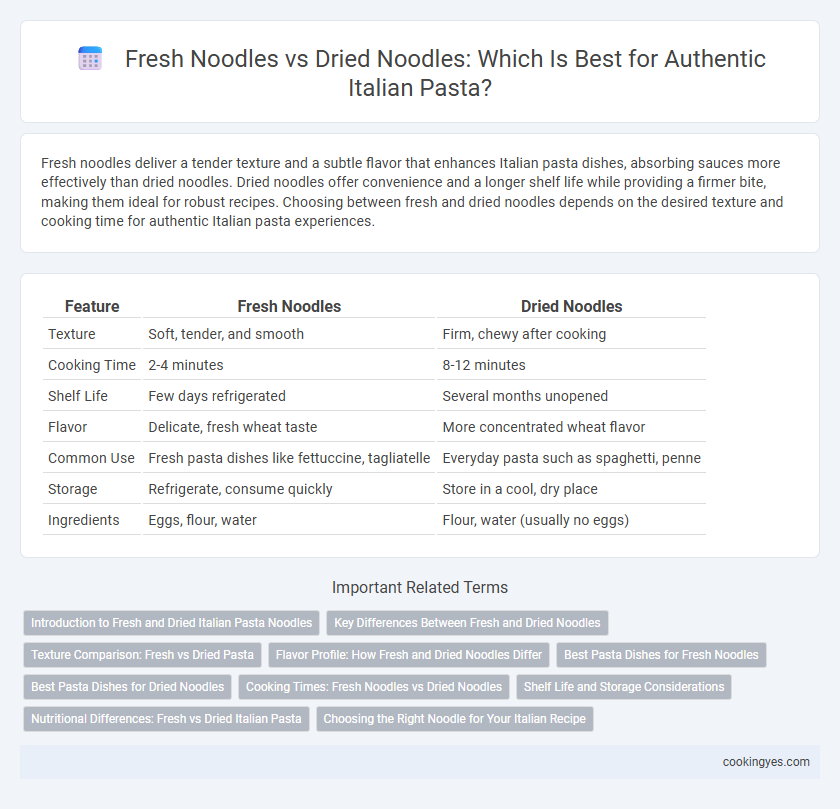Fresh noodles deliver a tender texture and a subtle flavor that enhances Italian pasta dishes, absorbing sauces more effectively than dried noodles. Dried noodles offer convenience and a longer shelf life while providing a firmer bite, making them ideal for robust recipes. Choosing between fresh and dried noodles depends on the desired texture and cooking time for authentic Italian pasta experiences.
Table of Comparison
| Feature | Fresh Noodles | Dried Noodles |
|---|---|---|
| Texture | Soft, tender, and smooth | Firm, chewy after cooking |
| Cooking Time | 2-4 minutes | 8-12 minutes |
| Shelf Life | Few days refrigerated | Several months unopened |
| Flavor | Delicate, fresh wheat taste | More concentrated wheat flavor |
| Common Use | Fresh pasta dishes like fettuccine, tagliatelle | Everyday pasta such as spaghetti, penne |
| Storage | Refrigerate, consume quickly | Store in a cool, dry place |
| Ingredients | Eggs, flour, water | Flour, water (usually no eggs) |
Introduction to Fresh and Dried Italian Pasta Noodles
Fresh Italian pasta noodles boast a tender texture and quicker cooking time, often crafted from high-quality durum wheat and eggs, which enrich flavor and elasticity. Dried pasta, produced by slowly drying dough made from semolina flour, offers long shelf life and firmer bite, making it ideal for hearty sauces and extended storage. Understanding the distinctions between fresh and dried noodles is essential for selecting the perfect pasta type to complement specific Italian recipes and cooking techniques.
Key Differences Between Fresh and Dried Noodles
Fresh noodles provide a tender texture and quicker cooking time due to higher moisture content, making them ideal for delicate sauces and recipes requiring a softer bite. Dried noodles offer a longer shelf life and a firmer, chewier texture, often preferred for robust sauces and hearty dishes. The choice between fresh and dried pasta depends on desired texture, cooking method, and sauce compatibility, with fresh noodles excelling in silky, light applications and dried noodles in more robust, flavorful preparations.
Texture Comparison: Fresh vs Dried Pasta
Fresh noodles offer a tender, silky texture that quickly absorbs sauces, enhancing flavor integration in Italian pasta dishes. Dried noodles provide a firmer, chewier bite and hold their shape better during longer cooking times, ideal for hearty recipes. The moisture content difference between fresh (approximately 30%) and dried pasta (around 12%) significantly influences texture and cooking properties.
Flavor Profile: How Fresh and Dried Noodles Differ
Fresh noodles offer a delicate, tender texture with a subtle wheat flavor that enhances the overall dish. Dried noodles, while firmer and more resilient, develop a concentrated, slightly toasted taste due to the dehydration process. Italian pasta recipes often select fresh noodles for light sauces to highlight freshness, whereas dried noodles suit robust sauces where their intensive flavor can stand out.
Best Pasta Dishes for Fresh Noodles
Fresh noodles offer a tender texture and absorb sauces more effectively, making them ideal for delicate Italian pasta dishes like fettuccine Alfredo and tagliatelle Bolognese. Dried noodles provide a firmer bite and longer shelf life, suitable for robust recipes such as spaghetti carbonara and penne arrabbiata. The best pasta dishes for fresh noodles emphasize smooth, creamy sauces and quick cooking times that highlight their silky consistency.
Best Pasta Dishes for Dried Noodles
Dried noodles offer ideal texture and firmness that complement classic Italian pasta dishes like spaghetti carbonara, penne arrabbiata, and lasagna, providing consistent al dente results. Their low moisture content extends shelf life and allows for easy storage, making them a staple in Italian kitchens worldwide. Dried pasta absorbs rich sauces effectively, enhancing flavors in hearty recipes such as bolognese and puttanesca.
Cooking Times: Fresh Noodles vs Dried Noodles
Fresh noodles typically cook faster, requiring only 2 to 4 minutes due to their higher moisture content, while dried noodles usually take 8 to 12 minutes to reach optimal texture. The cooking time difference is crucial for achieving the ideal al dente firmness in Italian pasta dishes, with fresh noodles offering a softer, more delicate bite. Dried noodles provide a chewier texture and longer shelf life, affecting both preparation time and final dish characteristics.
Shelf Life and Storage Considerations
Fresh noodles for Italian pasta have a shorter shelf life, typically lasting 2 to 5 days when refrigerated at 35-40degF, requiring airtight packaging to prevent moisture loss and contamination. Dried noodles offer an extended shelf life of up to two years when stored in a cool, dry place away from direct sunlight and humidity, preserving their texture and flavor over time. Proper storage conditions are critical for both types to maintain quality and prevent spoilage, with fresh noodles requiring refrigeration and dried noodles benefiting from sealed, moisture-proof environments.
Nutritional Differences: Fresh vs Dried Italian Pasta
Fresh Italian pasta contains higher moisture content, resulting in a softer texture and slightly lower calorie density compared to dried pasta. Dried pasta offers greater shelf stability and a more concentrated nutrient profile, including complex carbohydrates and moderate protein levels. Both types provide essential B vitamins and minerals, but fresh pasta typically retains more delicate nutrients sensitive to heat during drying.
Choosing the Right Noodle for Your Italian Recipe
Fresh noodles for Italian pasta offer a tender texture and absorb sauces more readily, making them ideal for delicate recipes like tagliatelle with creamy sauces. Dried noodles provide a firm bite and longer shelf life, perfectly suited for hearty dishes such as spaghetti Bolognese or baked pasta. Selecting the right noodle depends on the desired texture and sauce compatibility in your Italian culinary creation.
Fresh noodles vs dried noodles for Italian pasta Infographic

 cookingyes.com
cookingyes.com